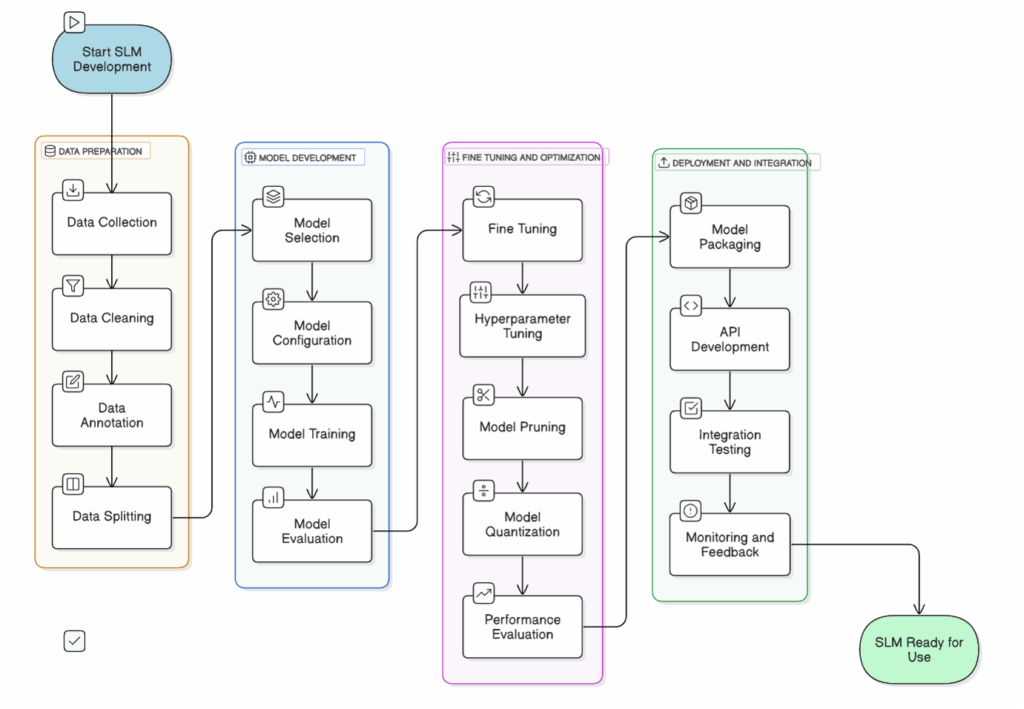
Enhancing Cost-Effectiveness and Ensuring Security and Compliance
Dr. Magesh Kasthuri, Distinguished Member and Chief Architect, Wipro Limited
In today’s fast-paced digital world, the development of language models tailored to specific domains or industries has become invaluable. Small Language Models (SLMs) provide a cost-effective and resource-efficient solution for organizations seeking to leverage artificial intelligence (AI) without the extensive overhead associated with larger models. This whitepaper delves into the methodology of developing SLMs, emphasizing their application in banking, financial services, capital markets, insurance, and healthcare. We will explore the technical architecture, building blocks, and use cases that demonstrate the value of SLMs in these sectors, while also addressing security and compliance concerns.
The Need for Small Language Models (SLMs)
Large language models (LLMs) such as GPT-3, GPT-4o from OpenAI, Gemini from Google, LLaMA from Meta are undeniably powerful, yet they come with significant computational costs and resource requirements. SLMs, on the other hand, are designed to be more efficient, making them ideal for domain-specific applications. By focusing on a narrower range of topics, these models achieve higher accuracy and relevance while reducing the strain on computational resources. This allows organizations to deploy AI solutions more quickly and at a lower cost.
Technical Architecture and Building Blocks
Developing an SLM involves several key components, which together form an efficient and robust architecture tailored to specific business needs. The primary building blocks include:
Data Collection and Preprocessing
The foundation of any language model is high-quality data. For SLMs, it is crucial to source data that is highly relevant to the target domain. This may involve collecting data from industry-specific sources such as financial reports, medical journals, or insurance claim records. Preprocessing steps include data cleaning, tokenization, and normalization, ensuring the data is in a format suitable for model training.
Model Selection and Training
Choosing the right model architecture is essential for developing an effective SLM. Common architectures include transformers, recurrent neural networks (RNNs), and convolutional neural networks (CNNs). Training the model on domain-specific data allows it to learn patterns and nuances unique to that industry, resulting in more accurate predictions and responses.

Figure: SLM Development stages and component view
Fine-Tuning and Optimization
Fine-tuning is the process of adjusting a pre-trained model on a smaller, domain-specific dataset. This step significantly enhances the model’s performance in the target domain while reducing training time and computational resources. Optimization techniques such as quantization and pruning can further improve the model’s efficiency.
Deployment and Integration
Once the SLM is trained and fine-tuned, it must be seamlessly integrated into the organization’s existing systems. This may involve deploying the model on cloud platforms, on-premises servers, or edge devices, depending on the specific requirements and constraints of the business.
Below table shows a comparison of LLMs and SLMs in terms of industrial applications and benefits.
| Feature | Large Language Models (LLM) | Small Language Models (SLM) | Industrial Examples |
| Size and Complexity | LLMs are vast and complex, requiring substantial computational resources. | SLMs are more streamlined, optimized for efficiency and specific tasks. | Capital Markets, Healthcare, Insurance, Security and Compliance |
| Data Requirements | LLMs rely on extensive datasets, often encompassing diverse topics and sources. | SLMs focus on targeted datasets, typically domain-specific, reducing data volume needs. | Capital Markets-Trading strategies; Healthcare- Diagnoses and treatment plans |
| Deployment Costs | Due to their scale, LLMs incur higher deployment and maintenance costs. | SLMs offer cost-effective solutions, being less resource-intensive. | Insurance-Claims processing; Healthcare- Virtual health assistants |
| Performance | LLMs can handle a wide range of tasks but may not be as efficient in specialized domains. | SLMs excel in specific tasks, delivering more accurate and faster results within their niche. | Insurance-Fraud detection; Security and Compliance- Regulatory adherence |
| Integration | Integrating LLMs requires significant infrastructure and may involve complex customization. | SLMs can be integrated into existing systems with relative ease and minimal adjustments. | Capital Markets- Trading platforms; Healthcare-EHR systems |
| Security and Compliance | LLMs need extensive measures to ensure data security and regulatory compliance. | SLMs, due to their focused scope, can implement robust security protocols more straightforwardly. | Healthcare- HIPAA compliance; General- GDPR adherence |
| Development and Training | LLMs require extensive training periods and sophisticated algorithms. | SLMs benefit from shorter training times and simpler model architectures. | Banking and Financial Services- Customer service automation; Healthcare- Personalized patient care |
Use Cases and Implementation Examples
Banking
In the banking sector, SLMs can be employed to enhance customer service through chatbots and virtual assistants. These models can handle a wide range of inquiries, from account information to loan applications, with high accuracy and efficiency. For instance, a banking SLM might be trained on transaction data, enabling it to detect and prevent fraudulent activities. The technical architecture for such a solution would involve integrating the SLM with the bank’s customer relationship management (CRM) system and transaction monitoring tools.
Financial Services
SLMs can streamline processes in financial services by automating the analysis of market trends and sentiment. By training an SLM on financial news, social media posts, and market reports, organizations can gain real-time insights into market movements and investor sentiment. This can aid in making informed investment decisions and managing portfolios effectively. The architecture here would include data pipelines for continuous data ingestion and a real-time analytics engine to process and visualize the insights generated by the SLM.
Capital Markets
In capital markets, SLMs can be used to automate trading strategies and enhance decision-making. By analyzing historical trading data and financial statements, an SLM can identify patterns and predict future market behavior. This allows traders to execute strategies with greater precision and confidence. The technical setup would involve integrating the SLM with trading platforms and ensuring low-latency data processing to keep up with the fast-paced nature of capital markets.
Insurance
The insurance industry can benefit from SLMs by automating claims processing and underwriting. By training models on historical claims data, policy documents, and customer interactions, insurers can streamline the assessment process and reduce the time required to settle claims. An SLM can also aid in detecting fraudulent claims, enhancing the overall risk management framework. The architecture would include integrating the SLM with the insurer’s claims management system and employing robust data security measures to protect sensitive information.
Healthcare
In healthcare, SLMs can revolutionize patient care by providing personalized recommendations and insights. By analyzing medical records, treatment guidelines, and research papers, an SLM can assist doctors in diagnosing conditions and suggesting treatment plans. It can also enhance patient engagement by powering virtual health assistants that provide timely responses to patient queries. The technical architecture would involve integrating the SLM with electronic health record (EHR) systems and ensuring compliance with healthcare regulations such as HIPAA.
Security and Compliance
When developing and deploying SLMs, it is imperative to address security and compliance concerns. This involves implementing robust encryption protocols to protect data at rest and in transit. Access controls and audit logs should be in place to monitor and restrict access to sensitive information. Furthermore, models should be designed to comply with industry-specific regulations, such as GDPR for data privacy in Europe or HIPAA in the healthcare sector.
Conclusion
Small Language Models offer a powerful and efficient alternative to large-scale models, particularly for domain-specific applications. By focusing on targeted data and optimizing model architectures, organizations can develop SLMs that not only save costs and resources but also enhance security and compliance. The use cases in banking, financial services, capital markets, insurance, and healthcare demonstrate the diverse potential of SLMs to transform business processes and deliver significant value. As AI continues to evolve, the development and deployment of SLMs will play a crucial role in enabling organizations to harness the power of language models effectively and responsibly.
